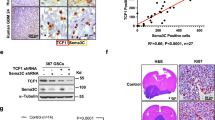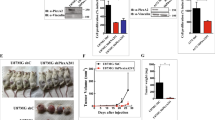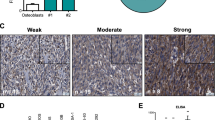Abstract
SEMA3B, a member of class 3 semaphorins, is a tumor suppressor. Competition with vascular endothelial growth factor (VEGF)165 explains a portion of the activity, whereas the VEGF-independent mechanism was not elucidated. We employed a microarray and screened for the genes whose expression was increased by SEMA3B in NCI-H1299 cells. Insulin-like growth factor-binding protein-6 (IGFBP-6), a tumor suppressor, showed greatest difference in the expression level. Introduction of IGFBP-6 cDNA reduced colony formation both on the dish surface and in soft agar. Insulin-like growth factor II, which antagonizes IGFBP-6, partly abrogated the effect. Inhibition of IGFBP-6 by small interfering RNA diminished the sub-G0/G1 population that was induced by SEMA3B and abrogated the growth suppressive effect of SEMA3B. We concluded that IGFBP-6 is the effector of tumor suppressor activity of SEMA3B in NCI-H1299 cells. It has been reported that β-catenin suppresses the expression of IGFBP-6. Introduction of β-catenin into the cells partly abrogated the growth suppressive effect of SEMA3B. Our result indicates that semaphorin signaling and β-catenin signaling converge on IGFBP-6 and antithetically affect their functions.
This is a preview of subscription content, access via your institution
Access options
Subscribe to this journal
Receive 50 print issues and online access
$259.00 per year
only $5.18 per issue
Buy this article
- Purchase on Springer Link
- Instant access to full article PDF
Prices may be subject to local taxes which are calculated during checkout





Similar content being viewed by others
References
Bach LA . (1999). Insulin-like growth factor binding protein-6: the ‘forgotten’ binding protein? Horm Metab Res 31: 226–234.
Bach LA, Hsieh S, Brown AL, Rechler MM . (1994). Recombinant human insulin-like growth factor (IGF)-binding protein-6 inhibits IGF-II-induced differentiation of L6A1 myoblasts. Endocrinology 135: 2168–2176.
Bach LA, Salemi R, Leeding KS . (1995). Roles of insulin-like growth factor (IGF) receptors and IGF-binding proteins in IGF-II-induced proliferation and differentiation of L6A1 rat myoblasts. Endocrinology 136: 5061–5069.
Barz T, Hoffmann A, Panhuysen M, Spengler D . (2006). Peroxisome proliferator-activated receptor gamma is a Zac target gene mediating Zac antiproliferation. Cancer Res 66: 11975–11982.
Behar O, Golden JA, Mashimo H, Schoen FJ, Fishman MC . (1996). Semaphorin III is needed for normal patterning and growth of nerves, bones and heart. Nature 383: 525–528.
Castro-Rivera E, Ran S, Thorpe P, Minna JD . (2004). Semaphorin 3B (SEMA3B) induces apoptosis in lung and breast cancer, whereas VEGF165 antagonizes this effect. Proc Natl Acad Sci USA 101: 11432–11437.
Chow LS, Lam CW, Chan SY, Tsao SW, To KF, Tong SF et al. (2006). Identification of RASSF1A modulated genes in nasopharyngeal carcinoma. Oncogene 25: 310–316.
Christensen CR, Klingelhofer J, Tarabykina S, Hulgaard EF, Kramerov D, Lukanidin E . (1998). Transcription of a novel mouse semaphorin gene, M-semaH, correlates with the metastatic ability of mouse tumor cell lines. Cancer Res 58: 1238–1244.
Clevers H . (2006). Wnt/beta-catenin signaling in development and disease. Cell 127: 469–480.
Denys H, Jadidizadeh A, Amini Nik S, Van Dam K, Aerts S, Alman BA et al. (2004). Identification of IGFBP-6 as a significantly downregulated gene by beta-catenin in desmoid tumors. Oncogene 23: 654–664.
Feng X, Bonni S, Riabowol K . (2006). HSP70 induction by ING proteins sensitizes cells to tumor necrosis factor alpha receptor-mediated apoptosis. Mol Cell Biol 26: 9244–9255.
Firth SM, Baxter RC . (2002). Cellular actions of the insulin-like growth factor binding proteins. Endocr Rev 23: 824–854.
Gallicchio MA, Kneen M, Hall C, Scott AM, Bach LA . (2001). Overexpression of insulin-like growth factor binding protein-6 inhibits rhabdomyosarcoma growth in vivo. Int J Cancer 94: 645–651.
Grellier P, De Galle B, Babajko S . (1998). Expression of insulin-like growth factor-binding protein 6 complementary DNA alters neuroblastoma cell growth. Cancer Res 58: 1670–1676.
Gu C, Yoshida Y, Livet J, Reimert DV, Mann F, Merte J et al. (2005). Semaphorin 3E and plexin-D1 control vascular pattern independently of neuropilins. Science 307: 265–268.
Guttmann-Raviv N, Kessler O, Shraga-Heled N, Lange T, Herzog Y, Neufeld G . (2006). The neuropilins and their role in tumorigenesis and tumor progression. Cancer Lett 231: 1–11.
Hall KT, Boumsell L, Schultze JL, Boussiotis VA, Dorfman DM, Cardoso AA et al. (1996). Human CD100, a novel leukocyte semaphorin that promotes B-cell aggregation and differentiation. Proc Natl Acad Sci USA 93: 11780–11785.
He Z, Tessier-Lavigne M . (1997). Neuropilin is a receptor for the axonal chemorepellent Semaphorin III. Cell 90: 739–751.
Kannan K, Kaminski N, Rechavi G, Jakob-Hirsch J, Amariglio N, Givol D . (2001). DNA microarray analysis of genes involved in p53 mediated apoptosis: activation of Apaf-1. Oncogene 20: 3449–3455.
Kato M, Ishizaki A, Hellman U, Wernstedt C, Kyogoku M, Miyazono K et al. (1995). A human keratinocyte cell line produces two autocrine growth inhibitors, transforming growth factor-beta and insulin-like growth factor binding protein-6, in a calcium- and cell density-dependent manner. J Biol Chem 270: 12373–12379.
Koike H, Ito K, Takezawa Y, Oyama T, Yamanaka H, Suzuki K . (2005). Insulin-like growth factor binding protein-6 inhibits prostate cancer cell proliferation: implication for anticancer effect of diethylstilbestrol in hormone refractory prostate cancer. Br J Cancer 92: 1538–1544.
Kolodkin AL, Matthes DJ, Goodman CS . (1993). The semaphorin genes encode a family of transmembrane and secreted growth cone guidance molecules. Cell 75: 1389–1399.
Leng SL, Leeding KS, Whitehead RH, Bach LA . (2001). Insulin-like growth factor (IGF)-binding protein-6 inhibits IGF-II-induced but not basal proliferation and adhesion of LIM 1215 colon cancer cells. Mol Cell Endocrinol 174: 121–127.
Mac Gabhann F, Popel AS . (2006). Targeting neuropilin-1 to inhibit VEGF signaling in cancer: comparison of therapeutic approaches. PLoS Comput Biol 2: e180.
Martin JL, Willetts KE, Baxter RC . (1990). Purification and properties of a novel insulin-like growth factor-II binding protein from transformed human fibroblasts. J Biol Chem 265: 4124–4130.
Miao HQ, Soker S, Feiner L, Alonso JL, Raper JA, Klagsbrun M . (1999). Neuropilin-1 mediates collapsin-1/semaphorin III inhibition of endothelial cell motility: functional competition of collapsin-1 and vascular endothelial growth factor-165. J Cell Biol 146: 233–242.
Nasarre P, Kusy S, Constantin B, Castellani V, Drabkin HA, Bagnard D et al. (2005). Semaphorin SEMA3F has a repulsing activity on breast cancer cells and inhibits E-cadherin-mediated cell adhesion. Neoplasia 7: 180–189.
Nelson WJ, Nusse R . (2004). Convergence of Wnt, beta-catenin, and cadherin pathways. Science 303: 1483–1487.
Ochi K, Mori T, Toyama Y, Nakamura Y, Arakawa H . (2002). Identification of semaphorin3B as a direct target of p53. Neoplasia 4: 82–87.
Pasterkamp RJ, De Winter F, Holtmaat AJ, Verhaagen J . (1998). Evidence for a role of the chemorepellent semaphorin III and its receptor neuropilin-1 in the regeneration of primary olfactory axons. J Neurosci 18: 9962–9976.
Scholl FA, Betts DR, Niggli FK, Schafer BW . (2000). Molecular features of a human rhabdomyosarcoma cell line with spontaneous metastatic progression. Br J Cancer 82: 1239–1245.
Sekido Y, Bader S, Latif F, Chen JY, Duh FM, Wei MH et al. (1996). Human semaphorins A(V) and IV reside in the 3p21.3 small cell lung cancer deletion region and demonstrate distinct expression patterns. Proc Natl Acad Sci USA 93: 4120–4125.
Soker S, Fidder H, Neufeld G, Klagsbrun M . (1996). Characterization of novel vascular endothelial growth factor (VEGF) receptors on tumor cells that bind VEGF165 via its exon 7-encoded domain. J Biol Chem 271: 5761–5767.
Soker S, Takashima S, Miao HQ, Neufeld G, Klagsbrun M . (1998). Neuropilin-1 is expressed by endothelial and tumor cells as an isoform-specific receptor for vascular endothelial growth factor. Cell 92: 735–745.
Sueoka N, Lee HY, Wiehle S, Cristiano RJ, Fang B, Ji L et al. (2000). Insulin-like growth factor binding protein-6 activates programmed cell death in non-small cell lung cancer cells. Oncogene 19: 4432–4436.
Tomizawa Y, Sekido Y, Kondo M, Gao B, Yokota J, Roche J et al. (2001). Inhibition of lung cancer cell growth and induction of apoptosis after reexpression of 3p21.3 candidate tumor suppressor gene SEMA3B. Proc Natl Acad Sci USA 98: 13954–13959.
Tran TS, Kolodkin AL, Bharadwaj R . (2007). Semaphorin regulation of cellular morphology. Annu Rev Cell Dev Biol 23: 263–292.
Usami N, Sekido Y, Maeda O, Yamamoto K, Minna JD, Hasegawa Y et al. (2003). Beta-catenin inhibits cell growth of a malignant mesothelioma cell line, NCI-H28, with a 3p21.3 homozygous deletion. Oncogene 22: 7923–7930.
Yao R, Wang Y, Lubet RA, You M . (2002). Differentially expressed genes associated with mouse lung tumor progression. Oncogene 21: 5814–5821.
Yu J, Zhang L, Hwang PM, Kinzler KW, Vogelstein B . (2001). PUMA induces the rapid apoptosis of colorectal cancer cells. Mol Cell 7: 673–682.
Acknowledgements
We thank Ms Akemi Yokote for technical assistance. This study was supported in part by the following grants-in-aid: 1) for scientific research (nos. 18390242 and 16590738) from the Japan Society for the Promotion of Science and 2) for Comprehensive Research on Aging and Health from the Ministry of Health, Labor and Welfare, Japan.
Author information
Authors and Affiliations
Corresponding author
Additional information
Supplementary Information accompanies the paper on the Oncogene website (http://www.nature.com/onc)
Supplementary information
Rights and permissions
About this article
Cite this article
Koyama, N., Zhang, J., Huqun et al. Identification of IGFBP-6 as an effector of the tumor suppressor activity of SEMA3B. Oncogene 27, 6581–6589 (2008). https://doi.org/10.1038/onc.2008.263
Received:
Revised:
Accepted:
Published:
Issue Date:
DOI: https://doi.org/10.1038/onc.2008.263
Keywords
This article is cited by
-
In Vitro Model for Studying of the Role of IGFBP6 Gene in Breast Cancer Metastasizing
Bulletin of Experimental Biology and Medicine (2018)
-
The Expression of IGFBP6 after Spinal Cord Injury: Implications for Neuronal Apoptosis
Neurochemical Research (2017)
-
Recent insights into the actions of IGFBP-6
Journal of Cell Communication and Signaling (2015)
-
Proteomic analysis of human vitreous humor
Clinical Proteomics (2014)
-
Downregulation of Insulin-like growth factor binding protein 6 is associated with ACTH-secreting pituitary adenoma growth
Pituitary (2014)



